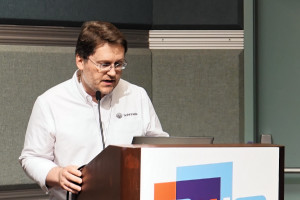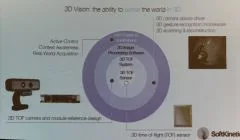A speaker from the Fraunhofer in Dresden gave a presentation on the bidirectional microdisplay that it has developed. It is said to be ideal for gaze tracking, while showing data to the user. However, we covered the technology in our SID report last week, where we got more information. See Fraunhofer Shows Bidirectional SVGA Microdisplay at SID.
The next session was on mapping the 3D world.
 Tim Droz is from GM SoftKinetic (SK) and he started by saying that there is a long way to go to get to where people want to be in tracking and building models of the world in a virtual space. 3D vision means the ability to sense static and dynamic objects.
Tim Droz is from GM SoftKinetic (SK) and he started by saying that there is a long way to go to get to where people want to be in tracking and building models of the world in a virtual space. 3D vision means the ability to sense static and dynamic objects.
SK makes hardware using “Time of Flight” to get a point cloud of objects. This data then needs processing to extract and identify objects with shape, scale and movement. SK aims to create photorealistic AR, although it is not there yet.
Shape and scale is determined by software and by getting the data at high speed, you can track motion. You can check for occlusion and you can add shadows, once you know where objects are. You can track hand movements, so the user can use gestures to control objects, but you can also track others for more social applications.
SK technology is being integrated into AR products. Challenges are inside and outside operations, especially when they are very close or far which also means small areas and large areas and fast and slow moving objects. The depth map is created at from 30 to 60Hz.
Accuracy is 1% of the measured depth and the array of points is 320 x 240.


